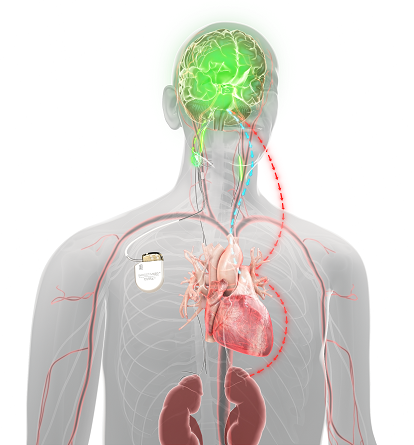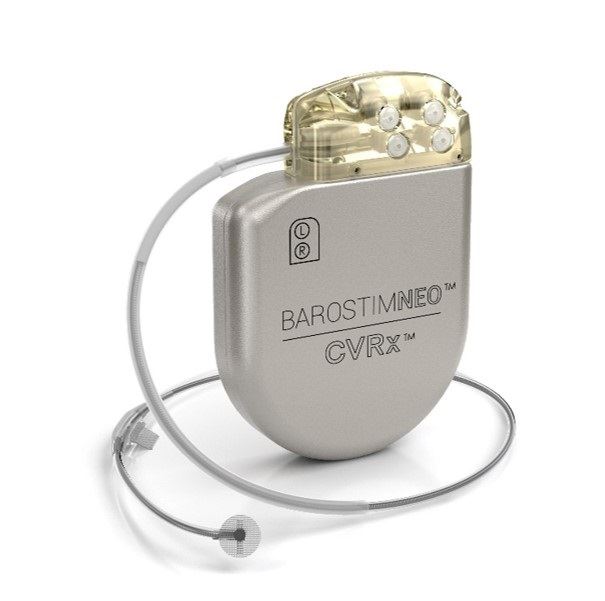Barostim Implant Regulates Blood Flow in People with Heart Failure
Innovative Device Uses the Body's Own Reflexes to Improve Cardiovascular Function
 Barostim Baroflex Activation Therapy uses an implantable device that sends
electrical signals to trigger the body’s own natural blood flow
regulation system.
Barostim Baroflex Activation Therapy uses an implantable device that sends
electrical signals to trigger the body’s own natural blood flow
regulation system.
It is the first medical technology approved by the Food and Drug Administration that uses neuromodulation — the power of the brain and nervous system — to improve the symptoms of patients with systolic heart failure. Systolic heart failure is also called heart failure with reduced ejection fraction (HFrEF), in which blood flows too slowly for the body’s need for blood and oxygen. This can cause disruptions to bodily functions and may have life-threatening consequences.
The innovative Barostim technology is designed for patients with heart failure who currently have no proven treatment options. It offers the potential to improve quality of life and reduce health risks associated with heart failure, including heart and kidney disease, stroke and death.
To learn whether the Barostim device is right for you, request an appointment to speak with an RWJBarnabas Health cardiologist.
How Does Barostim Baroflex Activation Therapy Work?
A person’s body senses changes in blood pressure and other blood flow changes through pressure sensors called baroreceptors that are found on the carotid artery and in the carotid sinus. These sensors measure and report blood flow to the brain, which compares it to the body’s needs. For example, higher blood pressure is good for exercising, while lower blood pressure is appropriate during sleep or other periods of reduced activity.
 The Barostim device is implanted under the collarbone and attached with
thin leads to the carotid artery. It communicates with an external device
doctors use to non-invasively regulate the activation energy therapy from
the device to the leads.
The Barostim device is implanted under the collarbone and attached with
thin leads to the carotid artery. It communicates with an external device
doctors use to non-invasively regulate the activation energy therapy from
the device to the leads.
The device sends electrical pulses to baroreceptors located in the wall of the carotid artery. Baroreceptors trigger the body’s main cardiovascular reflex called the baroreflex, which in turn triggers an autonomic response to the heart. “Autonomic” means it is part of the body’s systems that are not consciously controlled by the brain.
When activated, signals are sent through neural pathways to the brain that responds by telling the:
- Arteries to relax, making it easier for blood to flow through the body and reducing cardiac exertion.
- Heart to slow down, allowing more time for the organ to fill with blood.
- Kidneys to reduce fluid in the body, lowering both excessive blood pressure and workload on the heart.
The therapy is designed to restore balance to the autonomic nervous system and reduce the symptoms of heart failure.
What Are the Benefits of Barostim Baroflex Activation Therapy?
- Barostim is Adjustable. Barostim can be adjusted to meet each patient’s individual therapy needs, making it the only personalized medical device therapy available for the treatment of hypertension and heart failure.
- Can be Turned Off and On at Will. Barostim Baroflex Activation Therapy is a fully reversible treatment option. Since it uses electrical stimulation of the baroreceptors, which does not alter or destroy the structure of the baroreflex, doctors can turn the therapy off by simply pressing a button. This means that they can easily observe the difference it makes in blood pressure and other parameters simply by turning it off and on.
- Functions Automatically Without Patient Engagement. Barostim automatically and continuously activates the baroreflex. You don’t have to do anything. With heart medications, people have to take them regularly. This is often a problem for patients with heart failure, who either don’t remember to do so or do not do so for other reasons.
Barostim Is Medicare-Approved
Barostim is the recipient of the Centers for Medicare and Medicaid Services (CMS) Transitional Pass-Through Payment Status (TPT) and inpatient New Technology Add-On Payment (NTAP), and is approved to treat the thousands of Medicare patients suffering from the effects of heart failure.
What to Expect Before the Procedure to Implant the Barostim Device
Before the procedure, your doctor may perform a variety of diagnostic tests, including:
- Blood tests
- Cardiac catheterization
- X-Rays
- Echocardiogram (ECHO)
- Electrocardiogram (EKG/ECG)
- Stress test
How to Prepare for the Procedure
Prior to surgery, your doctor and treatment team will explain to you what to expect before, during, and after the procedure and potential risks of the procedure. Talk to your doctor about:
- All medications, herbal products and dietary supplements you are currently taking and ask for their recommendations about each.
- Diabetes and how to adjust your medicine on the day of the procedure.
- Any allergies to medicines, latex, tape, iodine, and anesthetic agents.
- Any history of bleeding disorders.
- Any implanted device (e.g., pacemaker or implantable cardioverter defibrillator (ICD)).
- Any body piercings on your chest or abdomen.
Other recommendations include:
- Eat a normal meal the evening before the procedure. However, do not eat, drink or chew anything after midnight before your procedure. If you must take medications, only take them with sips of water.
- Leave all jewelry at home.
- Remove all makeup and nail polish.
- Wear comfortable clothing when you come to the hospital.
- If you normally wear dentures, glasses, or hearing devices at home, plan to wear them during the procedure.
What to Expect During Surgery
Barostim device implant is a minimally invasive cardiovascular procedure performed under general anesthesia in the operating room, and takes only 45 minutes.
- You will change into a hospital gown.
- A nurse will start the intravenous (IV) line in your arm which will administer medications and fluids during the procedure.
- Prior to the procedure, ultrasonography is used to locate the carotid bifurcation when the artery divides into two branches, which helps to identify the exact location of the lead or the wire.
- The 45-minute procedure includes a small 1-inch incision on the right side of the neck and a 2-inch incision over the right pectoral region under the collarbone. The incision on the neck is used to attached the lead or wire to the superficial aspect of the carotid artery, after mapping the area and choosing the right location eliciting a desired response such as lowering heart rate and blood pressure.
- Then the wire is tunneled under the skin and connected to the device battery which will be implanted in the pocket made under the skin on the right pectoral region under the collarbone.
- After the incisions are closed and sutured you will be woken up in the procedure room and then taken to post-op recovery suite for observation.
- Your doctor programs the device based on your requirements. You may go home the same day providing your care team feels it is appropriate, or you may need to stay in the hospital for observation overnight.
- You need to contact your doctor immediately if you experience tingling, twitching of the face, difficulty speaking and swallowing, or unusually low blood pressure or heart rate.
What to Expect After Barostim Implantation
After the procedure, you will be observed for a period of time as you emerge from the anesthesia. Most times, you’ll be able to go home within 24 hours after the procedure.
- A nurse will monitor your vital signs, the insertion site, and circulation and sensation in the affected leg or arm.
- You must stay in bed as long as recommended by your doctor.
- Tell your nurse right away if you feel any chest pain or tightness, or any other pain, as well as any feelings of warmth, bleeding, or pain at the insertion site.
- Your doctor will give you instructions to follow during your recovery.
At RWJBarnabas Health, we are the destination for ensuring your heart health. To learn more about Barostim Baroflex Activation Therapy and whether it is right for you, connect with one of our expert New Jersey cardiac specialists.
Do you have a question? Request more information and we will connect you with an RWJBarnabas Health cardiovascular expert.



